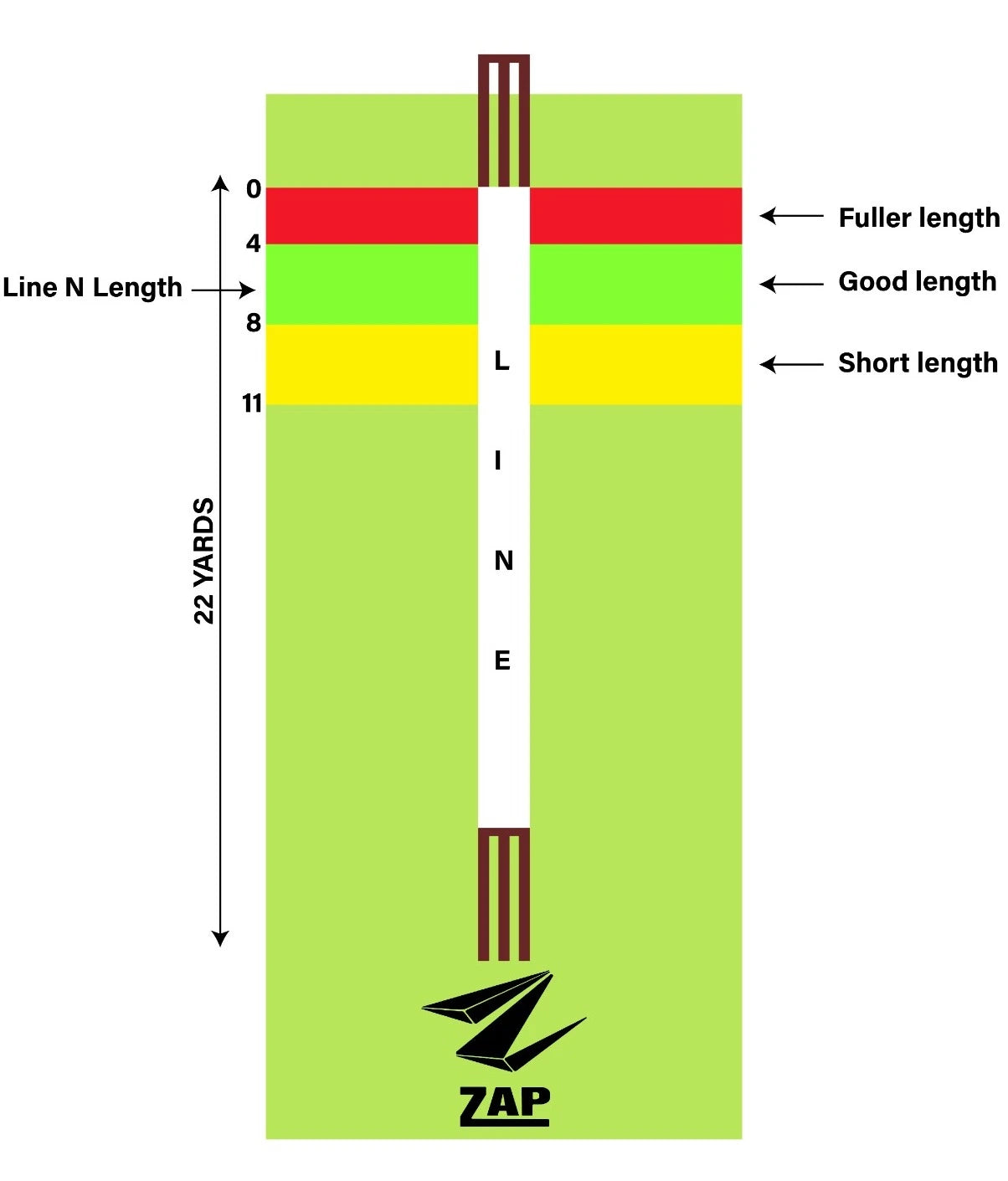Mastering Fast Bowling: Tips and Techniques
Whoever said cricket is a batsman’s game might have never faced lethal pace. To put it simply, a great batsman can win you matches but a great bowler will win you tournaments. Especially the pacers, who with their mastery in fast bowling, with the art of swing and seam make the batsmen fear for their lives, hoping that that ball does not come in and hit their batting pads, or take an edge of their cricket bat to get caught behind.

Credit: T20 World Cup
Fast Bowling is an art. Especially one that requires a tremendous amount of hard work, mixed with passion and grit. You need to have something special inside you, to be the best pacer in the world, just like Sir Curtly Ambrose, Dale Steyn, Glenn McGrath, and just how Jasprit Bumrah who has the special ability to hit those pinpoint yorkers or Jimmy Anderson, who can magically swing the red hard leather in the air in all directions. To become great at it, you need to develop a robust bowling technique in the initial years of your career.
In today’s chapter of ZAP Explains, let’s go through an expert lesson about Cricket Fast Bowling Tips to help you become an express pace maestro.
Cricket Tips and Techniques for Fast Bowling:
The 2 Important R’s: Run Up and Release:

One of the most important tips that cannot be overstated is the importance of a good run-up. It helps you generate momentum, build up your pace and push your limits.
- Budding fast bowlers who want to develop their pace should focus on the run-up pattern. Generally, a distance of 7-10 big steps is preferred.
- However, you can increase the distance once you become comfortable with your game.
- Don’t forget you mark your run up point with a pebble or by scratching the ground with your shoes.
- Keep the number of steps that you take for your run up constant, as it will help you build a mind muscle connection and will help in delivering the ball at the right spot consistently.
The next part is about the release.
- Take a deep breath and take a run up, and once you reach near the crease, take your jump, perform your bowling action and ensure your feet are firmly planted on the ground. Lean slightly forward to generate power and release the leather ball confidently and accurately and let your pace do the rest.
The combination of a good run up and a release is what adds pace to your deliveries. Having the proper technique and working hard to get better can make you the fastest bowler in the world.
The Fast Bowling Grip:
99 percent of your success as a pacer comes from your fast bowling grip, so make sure you're using the proper grip.
- Hold it in a nice seam position and you will master it. The grip determines how the ball exits our hands, as a result, it significantly affects the precision of our deliveries, making it one of the most crucial aspects of fast bowling.
- But, if your fingers are placed incorrectly, nothing will work, and the batsmen will always dominate you. You must have seen Jimmy Anderson, the balls he delivers are always perfect, a thing of beauty. That’s the reason it is very important for a pacer to work on his grip.
Seam Position – Straight Seam and Cross Seam Position:
A leather cricket ball is not completely spherical. A stitching called the seam joining the two leather halves runs through the middle. Because of this stitching, the seam is raised which changes the shape of the ball. So if your bowl a ball in such way that it lands on the seam, it might deviate from its original path and show movement, which can trick the batsman.
This is called seam movement and there are two ways to do this:
Straight Seam:

Bowling a ball on a straight seam can generate lateral movement after the bounce. It is important to use straight seam deliveries in the powerplay overs when the ball is new and the seam is heightened and stiff. This will ensure more lateral movement when you pitch it on the seam. This is how you do it:
- Simply keep your index and middle finger on the seam. Put your thumbs down below and the rest will work just fine. There is no rocket science, it is a plain process. What makes the real difference here is, going about it for hours in the nets.
Cross Seam:

This is a surprise delivery and there are a lot of bowlers who use this technique to pick up wickets in death overs in ODIs and T20s. When the seam lands on the cross seam, it generates an extra bounce and reaches the bats with a zip, and can catch the batsman by surprise. If it lands anywhere else, it can skid onto the batter. Here’s how you do bowl a cross-seam delivery:
- The cross seam delivery grip and the traditional straight-seam grip are extremely similar. The only difference is that you have to slightly modify the ball's position in your hand for this one.
- Hold the bat in a similar way as in the straight seam. All you need to do to switch from this grip to the cross seam grip by rotating the ball 90 degrees so that your seam runs horizontally across your fingers.
One thing to note is that if you're holding the ball in a cross seam position, it wont generate any swing in the air. For swing you need to hold it in a straighter seam position.
In Swing and Out Swing Bowling:
Swing Bowling in cricket is when the bowler delivers the ball in such a way that it moves through the air while it travels towards the batsman. This happens because of the ball's seam placement and the way air flows around it as it advances in the batsman's direction. There are two types of:
When the cricket ball swings, it becomes a challenge for batsmen as they can't anticipate where it will ultimately end. Even with just a slight amount of swing, there is a chance that you may leave the batsman bamboozled. When the ball comes in towards the batsman, the delivery is known as an inswinger, and when it goes out, it is an outswinger.
In swing (right handed batsman):

- Hold the ball with the seam pointing upwards and towards the direction of "fine leg."
- Position the shiny side towards the "off-side" of the pitch
- Keep the seam vertical and tilted as it travels through the air
- The ball will then swing or curve from the off-side of the pitch towards the leg-side, which is where a right-handed batsman stands
Outswing (Right handed batsman):

- Hold the ball with the seam pointing upwards and towards the direction of "third man"
- Position the shiny side towards the "leg side" of the pitch
- Keep the seam vertical and tilted as it travels through the air
- The ball will then swing or curve from the leg side of the pitch towards the off side, which is where a right-handed batsman stands.
Sure, swingers are extremely effective at the start of the match, when the ball is new, with both sides shiny, but at the death, it is sheer pace that wins matches. The toe crushing yorkers, the fiery bouncers and the surprising change of pace are always effective in the death.
How to Bowl Fast in Cricket:

Credit: Quora
The essence of fast bowling is speed and aggression. Watching pacers like Mitchell Johnson, Shoaib Akhtar, Shaun Tait and Mitchell Starc who haunted batsmen with sheer pace is extremely pleasing to the eye. Pace can help you pick up wickets, save runs, and put pressure onto the batsmen in any part of the match, be it with the new ball in and ODI or T20 game, or in the death overs. Superfast bouncers, toe crushing yorkers and those zapping length deliveries are a true test of the batsman’s mettle. Here’s how you can increase your speed in cricket:
Develop an Effective and Consistent Run Up:
- Your run-up generates momentum for your delivery, so focus on a balanced and rhythmic approach.
- Find a comfortable run-up length that allows you to build sufficient momentum without exhausting yourself.
- Practice your run-up to make it consistent and avoid hesitations that can hinder your speed.
Brace Your Front Leg at the time of release:
- Ensure your front leg is straight (braced) at the point of release to act as a pivot point.
- A braced front leg helps in generating power by quickly decelerating the lower body, propelling the upper body forward.
Make Use of Your Front Arm:
- Use your front arm effectively as a lever to pull your upper body through the bowling action.
- Delay pulling your front arm down to synchronize it with the rotation of your bowling arm, maximizing the energy transfer.
Align Your Body:
- Keep your hips and shoulders in line during your delivery, regardless of whether you have a front-on or side-on action.
- Proper alignment ensures the energy built up during your run-up is effectively transferred, reducing the risk of injuries.
Follow Through and Drive the Hips:
- Having a good follow through is a must for a perfect technique and an injury free career. A follow-through is a continuation of your run-up.
- Rather than standing still, keep up with your motion and run 4-5 steps more down the wicket, towards the batsmen.
- A smooth follow-through releases the stress and helps you gain momentum behind the ball.
- Most fast bowling-related injuries can happen in this phase. A sudden or abrupt stoppage in motion can lead to a ligament or muscle-related injury. Therefore, it's quite important to have a relaxed and momentum-rich follow-through.
Some Important Tips to Remember:
Enhance Your Flexibility:
-
Incorporate dynamic stretches in your warm-up routine to prepare your muscles for the bowling action.
-
Increased flexibility allows for a wider range of motion, potentially improving your speed.
Improve Your Strength:
- Focus on strengthening your core, legs, and shoulders, as they play a crucial role in the fast bowling process.
- A strong core aids in stability and force transfer, while strong legs help maintain speed even in challenging conditions.
Bowling at The Right Line and Length:
Arguably, the most crucial ability for a fast bowler is the ability to pitch controlled and accurate deliveries. If you can develop this ability, you'll be a very dangerous pacer to bat against! In actuality, some of the greatest seamers in history weren't all that quick. Rather, what made them lethal was their accuracy! Two names that readily come to mind are Shaun Pollock of South Africa and Glenn McGrath of Australia. Nearly every ball they pitched would be in a dangerous area for the batter, putting their decision-making to the test.
What is the Best Bowling Line and Length?

First of all, words like "good," "bad," "worst," "best," and so on are all relative. A seamer’s ability to pitch the ball well or poorly depends entirely on the condition of the pitch, the situations of the match, and other factors. For instance, the most lethal ball in cricket, the yorker, would be your last choice if a batsman like MS Dhoni was in front of you since we know what he is capable of doing with it. Similar to this, you would consider the short ball to be your best length if someone like Suresh Raina was batting, but if you go for a short delivery against Rohit Sharma, he'll easily play the pull shot and hit the ball out of the park.
Pitch conditions are also very important. It would be best as a pacer to pitch it at the good length for Indian pitches which are characteristically not very bouncy. For pitches in Australia, England and South Africa, which have extra bounce, going higher up the pitch will be your best bet as it will make it tricky for batsmen to judge the bounce.
Fast Bowling Variations:
Fast bowling is lethal, you can dominate the opponent just by your pace. But one very important tip from ZAP is to know the value that fast provides you and what it adds to your arsenal.
Slower Balls:

With extreme pace, you have the ability to bowl slower balls by taking off the pace and surprising the batsman, and forcing him to make mistakes and play a wrong shot. Change of pace works wonders in the death overs in t20 matches, be it the use of cutters, knuckle balls or back off the hand slower ones.
That’s why we see so many players practicing slower deliveries as an important fast bowling technique.
Gym Workout and Exercises For Fast Bowlers:
Having a strong body and working hard to build strength are important aspects of cricket. Bowling requires much more hard work than batting, so it is very obvious that pacers work much harder than batsmen. Fast bowling places strains on the body, and cricket injuries are currently plaguing many young professional players. Although the following cricket exercises cannot ensure that you won't ever get hurt, they will undoubtedly help you become stronger and more fit overall.
You must first understand the body physiology of a pacer to become great at it. Every player needs to have well-developed shoulders, strong legs and a strong and balanced core. These are the key element that you require to excel and stay injury free.
Stretching and warm-ups:

Credit: Business Insider
Warming up and stretching are the most crucial building blocks for preserving a high level of fitness. You must possess both mobility and flexibility. If your body is sore and tight, your ability to function at a professional level will get hindered. If you can counter this, only then can you add basic strength training in your routine. You can only push yourself for plyometrics and power training if your foundation is strong.
Plank:

Credit: Men's Health
Planks are a really good workout for pacers. They can be carried out practically anyplace and don't require any equipment. Planks are essential for preventing lower back injuries, which are particularly common among fast bowlers. They also assist in strengthening the core and lower back. You can add rotational motions at the hips to the standard plank hold to further work your core and abdominal muscles.
Isometric holds:
During isometric hold exercises, you involve your muscles without the motion of your body of joints. By holding weight in a specific posture, pushing or pulling an immovable resistance, or keeping a specific body position, you are essentially creating tension for your muscles to work through.
Fast bowling involves the transmission of energy. Transfer of energy, from one leg to the other and from the non-bowling hand to the bowling hand. Exercises that are isometric are crucial for quicker deliveries because they promote stability and energy transmission.
Squats:

Credit: Men's Health
Strong legs that can withstand a lot of mechanical stress are essential for pacers. Squats are among the best workouts for building lower limb strength and conditioning.
Single-leg Romanian deadlift:

Credit: Alo Moves Blog
Fast bowlers who are most likely to suffer back or lower limb injuries are recommended single-leg Romanian dead lifts as a part of their training regimen. This exercises targets the posterior chain of limb muscles and strengthens the glutes and hamstrings. They're a fantastic workout to prevent the stress-related leg and lower back injuries.
Chest press:

Credit: Men's Health
Fast bowlers require a lot of shoulder and chest muscle strength for a quick action. When it comes to the shoulders, there needs to be a balance between strength and flexibility. But using large weights over the shoulder may increase the chance of being hurt when working out. To increase strength and power, chest presses are advised in place of overhead shoulder workouts.
FAQ:
What is the typical speed of a fast bowler in cricket?
Pacers and Seamers typically deliver balls at speeds exceeding 90 miles per hour or about 135Kmph.
Why is seam position important in fast bowling?
Seam position affects the movement of the cricket ball in the air and off the pitch, making it difficult for batsmen to predict.
How do fast bowlers stay fit and prepared for matches?
These players undergo rigorous training, including cardio workouts, weight training, and agility drills, to enhance their fitness and endurance.
Why do fast bowlers often face injuries?
The immense force exerted on their bodies can lead to injuries, so managing these injuries and focusing on recovery is crucial.
How to increase bowling speed in Cricket?
Increasing your speed isn’t a simple process. It involves a lot of hard work, dedication, and discipline. Hitting the gym for regular workout and recovery sessions, marking your progress and growing gradually, and maintaining consistency on your training and practice will help you get faster with more control and be a better cricketer altogether.
Now that you have learnt everything about Fast Bowling, let's read some more articles that'll take your game to the next level:
Cricket Batting Techniques | Cricket Fielding Techniques | Cricket Wicketkeeping Techniques




Leave a comment